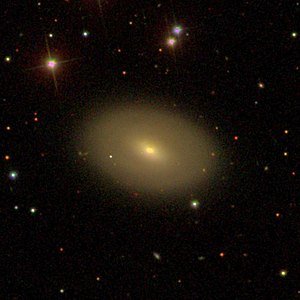NGC 7280
| Galaxy NGC 7280 |
|
|---|---|

|
|
| SDSS recording | |
| AladinLite | |
| Constellation | Toucan |
|
Position equinox : J2000.0 , epoch : J2000.0 |
|
| Right ascension | 22 h 26 m 27.6 s |
| declination | + 16 ° 08 ′ 54 ″ |
| Appearance | |
| Morphological type | SAB (r) 0+ / AGN |
| Brightness (visual) | 12.1 mag |
| Brightness (B-band) | 13.0 likes |
| Angular expansion | 2.1 ′ × 1.5 ′ |
| Position angle | 78 ° |
| Surface brightness | 13.2 mag / arcmin² |
| Physical data | |
| Redshift | 0.006154 ± 0.000017 |
| Radial velocity | 1845 ± 5 km / s |
|
Stroke distance v rad / H 0 |
(91 ± 7) x 10 6 ly (27.8 ± 2.0) Mpc |
| history | |
| discovery | William Herschel |
| Discovery date | October 15, 1784 |
| Catalog names | |
| NGC 7280 • UGC 12035 • PGC 68870 • CGCG 452-11 • MCG + 03-57-005 • 2MASX J22262757 + 1608537 • GC 4790 • H II 248 • h 2160 • KCPG 568A | |
NGC 7280 is a lenticular galaxy of the Hubble type SB0 / a in the constellation Toucan in the southern sky . It is an estimated 91 million light years away from the Milky Way and has a diameter of about 55,000 ly.
In the same area of the sky are the galaxies NGC 7272 and NGC 7291 , among others .
The object was discovered on October 15, 1784 by the astronomer William Herschel with his 18.7-inch reflector telescope and was later included in his New General Catalog by Johan Dreyer .
